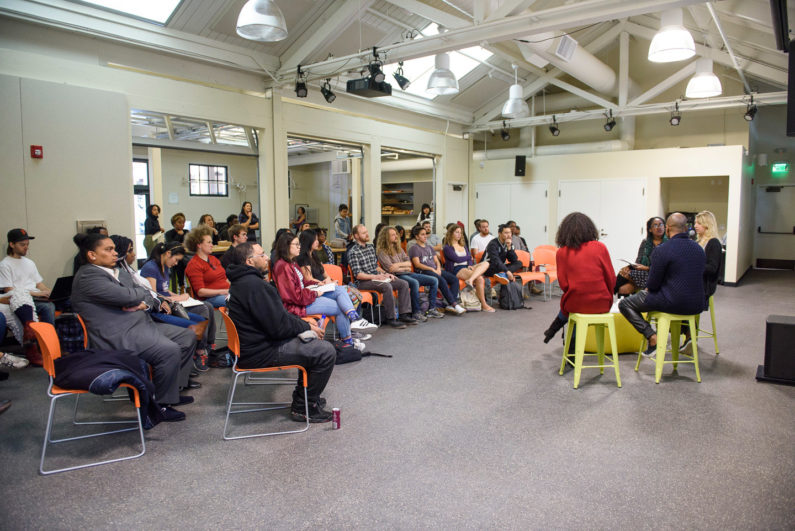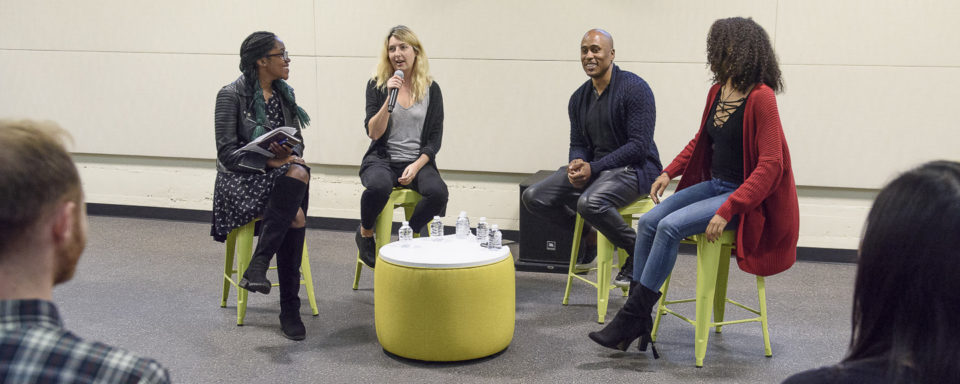Stanford is shedding light on career paths in the arts
From lunchtime Q&As with professional artists to a yearlong opportunity to explore the music industry, Stanford is building a wide variety of professional development opportunities for students who want to explore careers in the arts.
“Show me the way.” That is what Stanford offers students interested in pursuing careers in the arts.
Because arts organizations, by the nature of their work, recruit in non-traditional formats, the university is bringing art paths into the light in other ways. Among them are arts internships, hands-on arts courses, grants and a program called Art is My Occupation, or AiMO.
AiMO is an interdepartmental professional development program led by the Office of the Associate Dean for the Advancement of the Arts and a host of campus collaborators: the Anderson Collection; BEAM Stanford Career Education; the Cantor Arts Center; the Institute for Diversity in the Arts; and the departments of Art and Art History, Music, and Theater and Performance Studies.
Program goals include introducing students to career options in the arts, providing students with connections in the field, engaging arts alumni and giving students knowledge and skills to take the first steps building portfolios, writing resumes or applying for grants.
Ellen Oh spearheaded the launch of AiMO five years ago when she was the program administrator for the Institute for Diversity in the Arts. Comedy writer Seth Meyers was one of the first arts professionals invited to talk about building a career. AiMO moved with Oh when she joined the Office of the Associate Dean for the Advancement of the Arts as the director of professional development and student activities.
By highlighting the many opportunities that exist on campus and filling in some holes, Oh and her campus partners are working to create clear pathways for students who want to pursue careers in the arts. “From exploratory one-time events to immersive year-long experiences, we are showing students what the professional art world looks like and helping pave the way for them to get there,” she said.
Examples of recent AiMO programs include “Kickstart Your Art,” a presentation by Kickstarter founder Yancey Strickler with workshops on crowd-funding platforms; a Q&A with Brooklyn Museum Director Anne Pasternak; a “Financial Planning for Artists” workshop; and “Speed-Networking for Creatives” where students talked to 10 Stanford alums working in the arts, speed-dating style.
This academic year Oh invited Frannie Kelly and Ali Shaheed Muhammad of Microphone Check to talk about music and podcasting, alum Yaa Gyasi ’11 was on campus discussing the publication of her novel Homegoing, and Oh moderated a panel discussion with three Stanford alums working in the arts titled “How I Did It (or How I’m Trying).”
Courses and treks
Stanford offers dozens of professional development arts courses – from introductory to graduate level – that give students a sense of what it is like to work in the arts. The newest course is “Arts in Context: The Process of Cultural Production,” taught by Oh, who has more than 15 years experience working in arts organizations before joining Stanford, including Kearny Street Workshop, Sundance Institute and the Asian Art Museum of San Francisco.
Her course, which combines practical skill-building and real-world experience, provides students with some of the foundational skills necessary to work in the arts. Throughout the quarter, students will work in small groups with professional mentors to plan and produce an arts program at Yerba Buena Center for the Arts in San Francisco. This experiential learning will be interspersed with lectures on best practices in curating and programming; grant writing and other fundraising methodology; budgeting and financial management; contracts and other legal considerations; and public relations and marketing.
BEAM (an acronym for Bridging Education, Ambition & Meaningful Work) provides tailored support to arts students with career coaches dedicated to arts and humanities students, and industry consultants engaging arts employers. “BEAM Treks” is an experiential learning program where students visit and connect with employers, such as museums, publishers, and arts administration professionals. BEAM also hosts a Liberal Arts Career Fair in February.
Art work
Now in its eighth year, the Summer Internship Program in Arts Administration provides invaluable experience to Stanford students interested in pursuing careers as arts professionals in various aspects of administration, production and management. Internships give students an opportunity to step outside the classroom and build a set of skills applicable in their careers as artists, administrators and future leaders.

Stanford students such as these who are exploring career paths in the arts have a variety of professional development opportunities. (Image credit: L.A. Cicero)
The internships generally last nine weeks and are full-time positions of at least 35 hours per week. Students receive a $4,500 stipend for the summer, supported by gifts from individuals, plus financial aid if needed up to $6,100. Internships are open to current Stanford undergraduates, including graduating seniors.
Stanford is partnering with 24 summer internship host organizations in five cities this year: London, Los Angeles, New York, Tokyo and San Francisco.
Clara Galperin ’17, worked as a painting and sculpture intern in charge of reconstituting the historical narrative and art-historical trajectory of the painter Clay Spohn at the newly opened San Francisco Museum of Modern Art. “I have become so attached to the work of Clay Spohn that I will now be writing my honors thesis on my findings,” Galperin said. “The internship at SFMOMA was a truly life-changing experience and confirmed that I want to spend the rest of my career in a museum.”
A unique summer work experience opportunity in Los Angeles is for students enrolled in the Stanford | Warner Music Group Leadership Initiative. Students participate in a three-quarter program that begins with a spring course on the many facets of the music industry, followed by a summer fellowship with Warner Music Group, and finally a senior capstone project inspired by their experience.
During the academic year, students attending Stanford in New York and Stanford in Washington have been placed in arts internships at Cooper Hewitt Smithsonian Design Museum, the Rauschenberg Foundation, the Public Theater, IDEO New York, the Smithsonian museums, the National Portrait Gallery and the Kennedy Center, to name a few.
On-campus arts internships are also available to students. Elizabeth Quinlan ’13, a touring singer-songwriter and public relations professional at Shore Fire Media, got an early taste of the industry as an undergraduate intern on campus.
Quinlan, who now works with Americana, country and R&B artists, interned at Stanford’s Institute for Diversity in the Arts and helped produce a networking event for students who were interested in a career in music. “We brought together music industry pros, students and recent alums to break down some of the steps towards turning a creative passion into a sustainable career, and I came away with a new sense of clarity about how to build the foundation of my music career,” she explained. “I embraced the idea that working in music is not about having your head in the clouds; that it is just as much about staying organized and advocating for yourself as it is about being creative.”
Giuliano Kornberg ’15 and MA/MST ’16, was plotting an international relations career path when he found himself missing making music, which was a big part of his life before attending Stanford. He re-engaged with the music community on campus during his sophomore year by joining the Stanford Symphony Orchestra and later taking the course Professional Development in Music, taught by Joo-Mee Lee, lecturer in the Department of Music. He also gained work experience by interning at various times for the Department of Music, Stanford Arts Institute and Stanford Live.
After completing an internship at the Silicon Valley Community Foundation while finishing his MA/MST, followed by a stint at the San Francisco Opera, Kornberg was certain that a career in the arts, specifically working with an orchestra, was the path that he wanted to take. He contacted every member of the Association of California Symphony Orchestras and landed a job as a development associate at the Sacramento Philharmonic & Opera.
Listing the remarkable leadership of SP&O Executive Director Alice Sauro, the appeal of working with a small but talented staff, and the entrepreneurial challenge of helping to rebuild an organization that was on the verge of closing a few years ago, Kornberg said, “This is where I want to be.”
Launch
To further aid the launch of arts careers, Stanford offers the Stanford Alumni Arts Grant, which is supported by the Drs. Ben and A. Jess Shenson Funds and gifts from individuals. Each year a selected group of recent Stanford graduates has an easier time continuing artistic pursuits thanks to the grant program, now in its third year.
Stanford Alumni Arts Grants, awarded by the Office of the Associate Dean for the Advancement of the Arts, support public productions, exhibitions, publications or other original works in any genre by providing up to $5,000 in support of facility or installation costs, technical production costs, printing and publication expenses, marketing and other expenses.
For Samantha Toh ’10 and MA ’11, who received an alumni grant in 2016, the grant meant more than financial support for a creative project. “By sending a signal that somebody else believed in my creative ideas, the grant helped to affirm my own dream of a career in the arts,” she said. “I grew up in an environment where the arts were constantly overlooked in favor of sectors that could bring tangible benefit or economic growth – like engineering or science. A grant from my alma mater, a university I have loved and respected, meant a lot in that respect.”
Toh’s project was also a means to reach out to the arts community and make connections with people involved in the arts in Beijing, where she is currently located. Her project, Guerrilla Fiction, took the form of roughly 150-word ultra-short stories in English and Chinese that were distributed in independent locations across the city on postcards. “A few people have reached out to ask me about the project and explore possible collaborations. The stories have also helped to establish my identity as a writer in Beijing, which has in turn opened up doors within the community. For example, I have received invitations to do readings, to publish, and to participate in book clubs and writing circles that I never knew existed before.”
Liftoff.

